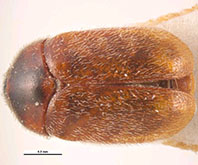Read the latest information on
Foot-and-mouth disease

Melon fly (Zeugodacus cucurbitae, formerly B. cucurbitae) are regularly found on islands in Torres Strait, having been blown in by monsoon winds.
Australia’s top 40 least wanted plant pests and diseases have recently been named.
The list came from a comparison of the possible ways that pests can enter Australia, the likelihood of them entering, their ability to become established and spread, and the consequences for businesses, human health and the environment if they do.
The broadacre and horticulture crops at risk from these pests are worth about $27.9 billion and forestry is valued at $2 billion. And how do you put a value on the health of unique Australian flora that could be harmed?
The nationally significant top three pests, with the greatest potential cost and impact, are: Xylella fastidiosa, Khapra beetle and exotic fruit flies.
Public enemy number one is Xylella fastidiosa. It could enter Australia via imported plant propagation material or by infected plant sucking insects that can hitch a ride on anything that is imported.
There are over 350 native, commercial and ornamental plant species at risk from this single pest, which could devastate gardens, horticultural crops and native flora.

The signs of infection with Xylella could easily be confused with other things that can affect the health of many crops.
There is no treatment for Xylella, and no documented example of it ever being eradicated once it has become established.
Because the symptoms can be confused with other diseases, it could go undiagnosed for a while, giving a chance to become established before you realise it’s there.
Next on the list is Khapra beetle, one of the world’s most feared grain pests.
These beetles can arrive in cargo, machinery, food or mail items, or be brought in by travellers in personal effects. Once here, they can spread easily through the movement of seed, straw, stored grain, cargo or machinery.
It’s a small but tough beetle: the larvae are able to survive dormant for up to two years with very little to feed on.
Khapra beetle larvae and adults actually made it to South Australia earlier this year, but were confined to a number of warehouses in Adelaide and Kangaroo Island, which were fumigated to destroy the pest.

Khapra beetle is one of the world’s most destructive pest of stored grain. This pest was eradicated from warehouses in Adelaide and Kangaroo Island earlier this year.
Number three is actually a collection of pests, namely fruit flies, the world’s most destructive horticultural pests. Fruit flies make the top three because over 300 types of fruit and vegetables can carry the flies, eggs or pupae.
While Australia already has some types of fruit fly pests, we are free from some of the more damaging ones. They can be blown in by monsoon winds or arrive on imported fruit or plant material. Once here, the flies could spread quickly through the movement of infested products.
The threat is very real. Some of these flies are regularly found on islands of the Torres Strait during the wet season. But they are eradicated before they get a chance to move south and into production areas on the mainland.
You can see the complete list of 40 national priority pests on the Department of Agriculture and Water Resources web site. There’s also some videos on YouTube for the top three pests.
Whether they are on the top 40 or not, preventing any pest or disease from entering Australia is far better than the ongoing cost and effort required to control them.
To do your bit to prevent these pests from becoming a problem in Australia, check what you can and cannot bring into the country. And if you do see anything unusual on new machinery or equipment, your crops or garden plants, contact the Exotic Plant Pest Hotline on 1800 084 881.